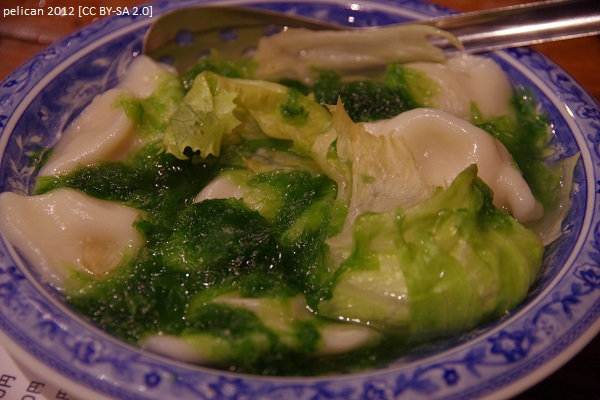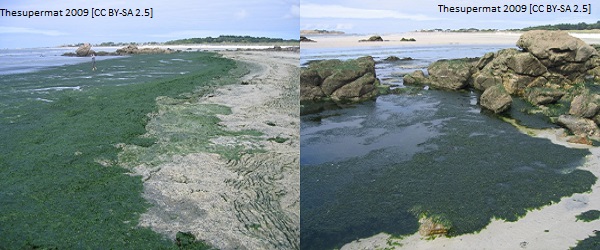by Matthew Norton
Sea lettuce is a collective name used for green seaweeds of the genus Ulva, although it is more commonly associated with the ‘type’ species Ulva lactuca and Ulva linza, due to the their flat bodies that resemble a lettuce. Normally we see them as fully formed seaweeds, washed up on the shore or attached to the seabed, but to get to this point they need to settle on the seabed and then properly develop and grow. However, they heavily rely on the influence of marine bacteria, which may come as a surprise as bacteria are often thought of as organisms that cause disease, but in fact they are vital to the existence of all organisms larger than themselves.

As floating spores, the seaweed equivalent of plant seeds (sort of), Ulva seaweeds need some sort of signal to guide them to a suitable surface to settle on. Fortunately the bacteria found in microbial biofilms, which cover virtually all submerged surfaces, release chemical signals which draws these spores to the biofilm and encourages them to germinate. Once they settle they begin the development process which ultimately (all being well) produces a fully formed seaweed.
Key to this process is their ability to produce cells that are specialised for specific functions, a process called cell differentiation. A number of experiments suggest that Ulva seaweeds cannot achieve this without the influence of some bacteria, with Cytopghaga and Flavobacterium species being especially important [6]. This could not be more clearly than in Ulva seaweeds grown in their natural environment, or in cultures where suitable bacteria are present, compared to cultures where bacteria are excluded altogether, which reduces the seaweed to disorganised clumps.
As they develop, and once fully developed, the Ulva seaweeds can themselves become an attractive surface for other organisms to settle on, which could put some serious strain on them if this influx is not kept in check. Fortunately some bacteria, particularly Pseudoalteromonas, Phaeobacter and Alteromonas species, have demonstrated their antifouling ability, repelling algal spores, invertebrate larvae, fungi and other bacteria. However, they may not be 100% effective against other bacteria as the threat of pathogenic (disease causing) bacteria appears sufficient for the Ulva seaweed to invest in their own antimicrobial measures. Also, the inhibition of algal spore settlement by antifouling bacteria can be problematic for Ulva seaweeds if these bacteria are present in the biofilm.
All the above mentioned bacteria are clearly influential in the lives of these seaweeds, and we should take notice given the influence that seaweeds have on other marine organisms as a source of food, oxygen (due to photosynthesis) and shelter.
From a human perspective
Sea lettuce is eaten as seafood, raw and cooked in salads and soups respectively, in a number of countries, including Great Britain, Scandinavia, China and Japan, and is high in proteins, minerals and vitamins.

However, if not properly stored this seaweed can become a health hazard, releasing hydrogen sulphide (H2S) as it decomposes. At low concentrations this gas is just unpleasant, producing a vile ‘eggy’ smell, but larger concentrations can cause health problems such as nausea, fatigue and respiratory problems.
An infamous example is the accumulation of Ulva seaweeds on the coast of Brittany in the summer of 2009. Residents became alarmed when a horse rider was left unconscious after being exposed to the H2S fumes, sadly the horse was not so lucky, but efforts to remove the seaweed lead to the death of a lorry driver, who passed out at the wheel while transporting a load of decaying seaweed. A jogger was also believed to have died from exposure to seaweed fumes in 2017, again in Brittany.

There is also a risk that the sea lettuce we eat could be contaminated from the pollutants we release into the sea, in particular a number of studies have demonstrated their capacity to ‘soak up’ toxic heavy metals. This issue is not unique to seaweeds, with every source of seafood there is a risk of contamination, although seaweeds may be relatively ‘low risk’ due to their position at the bottom of food chains, which eliminates the risk of pollutants bioaccumulating through the food chain to us.
We could also use Ulva seaweeds to filter out pollutants from closed off water sources before being released into the environment. One study looked into using Ulva lactuca to filter out nitrogen based compounds, such as ammonia, from intensive fish farms, but this could be extended to farmlands, where the nitrates used in fertilisers can wash off into adjacent streams. This could help solve a major problem as waters saturated in nitrogen (and phosphorous) can cause microalgae populations to explode into blooms at the surface, suffocating all life below it as dead algae sink and decompose.
However, Ulva seaweeds also have the potential to bloom, as demonstrated by the outbreaks off the Brittany coast, and cause damage the environment and human health as a result.
By whatever means we exploit Ulva seaweeds there are risks involved, but they are risks we can manage. With appropriate monitoring we can ensure we only eat seaweed from locations that are (relatively) clean and by containing the seaweed we use to control pollution we minimise the risk of it getting out into environment. In the end it really comes down to common sense.

Sources
Wikipedia. 2018. Sea lettuce. https://en.wikipedia.org/wiki/Sea_lettuce. Last accessed 26/02/2018
Wikipedia. 2017. Ulva lactuca. https://en.wikipedia.org/wiki/Ulva_lactuca. Last accessed 26/02/2018
Wikipedia. 2017. Ulva linza. https://en.wikipedia.org/wiki/Ulva_linza. Last accessed 26/02/2018
Marshall et al. 2006. Effect of Marine Bacterial Isolates on the Growth and Morphology of Axenic Plantlets of the Green Alga Ulva linza
Ghaderiardakani et al. 2017. Bacteria-induced morphogenesis of Ulva intestinalis and Ulva mutabilis (Chlorophyta): a contribution to the lottery theory
Goecke et al. 2010. Chemical interactions between marine macroalgae and bacteria
Rao et al. 2007. Low densities of epiphytic bacteria from the marine alga Ulva australis inhibit settlement of fouling organisms
Dobretsov. 2009. Biofouling (eds. Dürr and Thomason). ISBN. 1444315471
Wheeler et al. 2006. Acyl‐homoserine lactones modulate the settlement rate of zoospores of the marine alga Ulva intestinalis via a novel chemokinetic mechanism
Shin. 2008. Rapid attachment of spores of the fouling alga Ulva fasciata on biofilms
Twigg et al. 2014. Interference with the germination and growth of Ulva zoospores by quorum‐sensing molecules from Ulva‐associated epiphytic bacteria
Egan et al. 2000. Phylogenetic relationship and antifouling activity of bacterial epiphytes from the marine alga Ulva lactuca Brief report
Dobretsov and Qian. 2002. Effect of bacteria associated with the green alga Ulva reticulata on marine micro-and macrofouling
Karthikeyan et al. 2007. Evaluation of the marine algae Ulva fasciata and Sargassum sp. for the biosorption of Cu (II) from aqueous solutions
El-Sikaily et al. 2007. Removal of toxic chromium from wastewater using green alga Ulva lactuca and its activated carbon
Sari and Tuzen. 2008. Biosorption of Pb (II) and Cd (II) from aqueous solution using green alga (Ulva lactuca) biomass
Cohen and Neori. 1991. Ulva lactuca biofilters for marine fishpond effluents 1. Ammonia uptake kinetics and nitrogen content.
BBC. 2009. Seaweed suspected in French death. http://news.bbc.co.uk/1/hi/world/europe/8242649.stm. Last accessed 26/02/2018
Bevan and Walker. 2017. Jogger dies ‘after being overcome by fumes from toxic seaweed as deadly as cyanide’. https://www.mirror.co.uk/news/uk-news/jogger-dies-after-being-overcome-9610916. Last accessed 26/02/2018
Paulert et al. 2007. Antimicrobial properties of extracts from the green seaweed Ulva fasciata Delile against pathogenic bacteria and fungi
United States Department of Labor. 2018. Hydrogen Sulphide. https://www.osha.gov/SLTC/hydrogensulfide/hazards.html. Last accessed 26/02/2018
Image sources
Peters. 2006. [CC BY-SA 3.0 (http://creativecommons.org/licenses/by-sa/3.0/)]. https://commons.wikimedia.org/wiki/File:Ulva_lactuca.jpeg
Kothe-Heinrich. 2012. [CC BY-SA 3.0 (https://creativecommons.org/licenses/by-sa/3.0)]. https://commons.wikimedia.org/wiki/File:Ulva_linza_Helgoland.JPG
pelican from Tokyo, Japan. 2012. [CC BY-SA 2.0 (https://creativecommons.org/licenses/by-sa/2.0)]. https://commons.wikimedia.org/wiki/File:Dumplings_with_sea_lettuce_(7770042204).jpg
Thesupermat. 2009. [CC BY-SA 2.5 (https://creativecommons.org/licenses/by-sa/2.5)]. https://commons.wikimedia.org/wiki/File:Mar%C3%A9e_verte_-_Ulva_armoricana_-_006.JPG
Thesupermat. 2009. [CC BY-SA 2.5 (https://creativecommons.org/licenses/by-sa/2.5)]. https://commons.wikimedia.org/wiki/File:Mar%C3%A9e_verte_-_Ulva_armoricana_-_003.JPG
All other images are public domain and do not require attribution